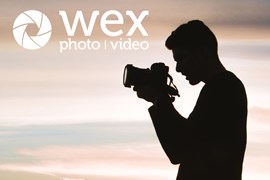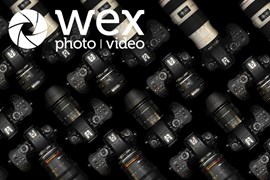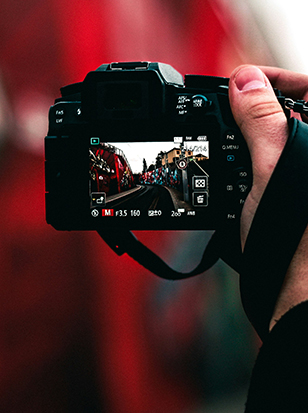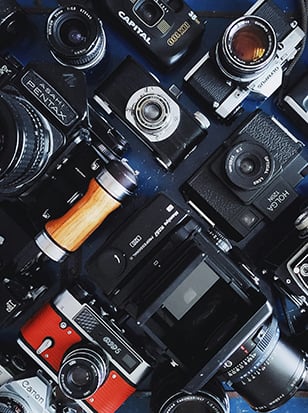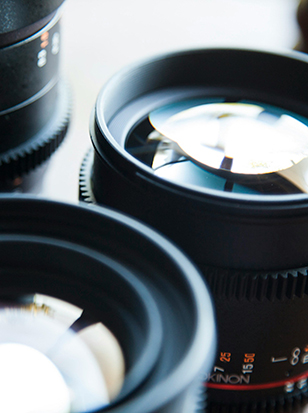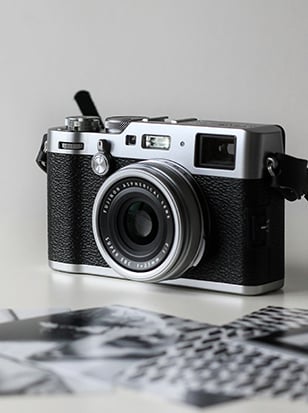
With the best lighting modifiers, you can take control of the shape of your light, and in turn take control of your images. It’s a common belief among photographers that the moment you first start to control your light is a significant milestone in your image-making journey. With these accessories, you can do just that.
Whether you plan to use flashguns, LED lights or whatever else, you can get plenty of use out of a host of different accessories. Our team of photography experts has broken it down into the key categories of lighting control accessories, and provided recommendations for each one.
Reflectors
Just as it sounds, reflectors are made for reflecting light. Specifically, they are used to bounce light towards your subject. This can be used to soften and diffuse an artificial source of light like a flashgun, or to enhance and bolster natural light. While many reflectors can be mounted to stands, they are often used handheld (though this does generally require an extra pair of hands).
The reflective material used comes in different colours. White reflectors create a soft, neutral tone; silver reflectors inject more brightness; and gold reflectors provide a warmer tone akin to golden hour light. Some reflectors can be bought with interchangeable covers, allowing you to swap between materials depending on the situation.
Reflectors are often collapsible, making them easy to store, transport and use on location.
We recommend…
Phottix 5-in-1 Light Multi Collapsible Reflector - 56cm
The Phottix 5-in-1 Light Multi Collapsible Reflector - 56cm is a combination of five separate reflector panels. These consist of Gold, Silver, White, Black, and Translucent. Suited to on-location shooting as well as varied studio setups, this lighting tool is ideal for portraiture, still life, close-up, nature, and product photography. As this is compatible with all available light sources to include daylight, tungsten, and flash, this multi-collapsible reflector is a great option for both beginner and pro-level digital creatives.
£20.00 View
This affordable reflector gives you multiple material options in a single unit. As well as silver, white and gold, it also has a black option, which absorbs light, and a translucent option that can be used to diffuse light. There’s also a carrying case included for easy transportation.
Umbrellas
Umbrellas, which work in conjunction with off-camera flashguns and standard studio lighting, come in two main varieties, each with a different purpose.
The first kind is designed with a translucent material, which softens light that is shone directly through it. Some photographers refer to these as ‘shoot-through’ umbrellas.
The second type has a reflective material on its inside, and these are designed to reflect light shone at it. By doing so, they can spread harsh light from a relatively concentrated source over a larger area.
Umbrellas remain a popular choice for photographers thanks to their light weight and affordability – and of course, for their effects. They attach quite simply to a stand by slotting through a hole inside an adapter, and can be moved and fixed in place as required.
We recommend…
Profoto Deep White Umbrella - Large
Perfect for daily, professional studio use, these Profoto umbrellas are well engineered and resilient; featuring a deep shape for increased lighting control, corrosion-resistant metal parts, 16 glass fibre supporting rods and heat-resistant fabrics. The umbrella includes a carry-bag and an optional - separately available - diffuser that can be fitted to further soften and even the light.
£290.00 View
Robustly constructed using high-end, corrosion-resistant materials, Profoto’s Deep White Umbrella is designed to withstand the rigours of daily use in a professional setting. Even if you won’t quite use it that often, you’ll find you get many years’ use out of this umbrella, with a deep design that offers superior lighting control.
Grids
Profoto Off Camera Flash II Grid 30 Degree
Profoto's OCF II grids are designed to limit the light spread of your flashgun. They help you control the light in your scene, adding contrast and theatre in your photos. The beauty of this is that even when out in the field, you can capture the perfect, professional-looking image for your clients without the need for extensive post-production editing. The grids can be clicked on and off of your OCF II holder at a moment's notice and can be stacked with Profoto's extensive OCF II gel options.
£60.00 View
This is a grid that mounts directly to a compatible flashgun using the Profoto Off Camera Flash II Grid + Gel Holder. Once fitted, it controls the spread of light for accurate, professional-looking illumination of subjects. It can also be used with Profoto gels if you want to give your light a particular hue (more on which further below).
Snoots
The purpose of a snoot is to channel light that would normally spread over a wider area into a narrower one. This allows the photographer to light only certain parts of the scene.
As an example, a photographer capturing a portrait can use a snoot to direct light to the subject’s face and leave the rest of the subject’s body – clothing, hands and so on – in shadow. Alternatively, they can light the subject with a separate light and use a snoot to direct light onto the subject’s hair to act as a hair light.
Snoots fit onto studio lamps and standard flashguns, and can have a number of other accessories used in conjunction with them to modify the light they output.
We recommend…
Godox SN-01 - Snoot
The Godox SN-01 Snoot is a modifier that provides a narrow focus of light on an object and adds precise control over where the light falls. It features a honeycomb grid attached at the end to further limit the beam’s spread, creating a soft-edged circle. The Bowens S-style accessory mount on the snoot allows you to easily attach it to your light.
£19.00 View
The Godox SN-01 Snoot is a modifier that provides a narrow focus of light on an object and adds precise control over where the light falls. It features a honeycomb grid attached at the end to further limit the beam’s spread, creating a soft-edged circle. The Bowens S-style accessory mount on the snoot allows you to easily attach it to your light.
Softbox
A softbox takes a relatively direct source of light and diffuses it through a material of some kind to create a softer result. They are usually rectangular in shape, although square and octagonal ones are also available.
Softboxes are typically used with studio lights, and are widely used by studio photographers to create a pleasingly even lighting in portraits and product shots.
They can have their front panel changed or adjusted so that they diffuse light differently, and can have these taken off to work with further accessories (such as grids, explained below).
The size of your softbox will also have a direct effect on the light emitted. Smaller softboxes, for example, are ideal when you need to light a face for a portrait. A larger soft box will produce a less powerful result as the light itself is being spread over a wider area.
You can also find smaller versions that are designed for hotshot mounted flashguns. These slip onto a flash head before being secured in place by Velcro or another means.
We recommend…
Godox QR-P90 Quick Release Parabolic Softbox - 90cm
Ideal for portrait and fashion photography, the Godox QR-P90 Quick Release Parabolic Softbox (90 cm) is a 16-sided light-shaper to add dimension and detail to your subjects. You can create natural-looking catchlights in the subject’s eyes and the parabolic design yields soft, focused light with a crisp edge. It is compatible with a wide range of Bowens mount strobes and continuous lights.
£113.00 View
Designed for quick setup, the Godox QR-P90 Quick Release Parabolic Softbox is suited for use in the studio or out on location. Its interior is reflective silver, and it has removable diffusers to deliver an even spread of light. It’s particularly recommended for creating attractive catchlights in the eyes of your portrait subjects.
Beauty Dish
As suggested by its title, a beauty dish is a modifier that is commonly used to create a more flattering light for portraiture.
It works on the same principle as a reflective umbrella in that light is bounced from its inner surface to the subject, although these are typically made of metal and smaller than most umbrellas.
Beauty dishes can be used to create a nice even light, but one that’s harder and more directional than that output by a softbox. They’re typically available in silver and white finishes and they are prized for the catchlights they create in a person’s eyes. You can also use them with other modifiers, such as grids and diffusers.
We recommend…
Godox BDr-W420 - Beauty Dish White 42cm
The Godox BDR-W420 Beauty Dish – White (42 cm) is a suitable choice for portrait and fashion photography. It bounces the light from a deflector and shifts it towards the reflector interior. This results in soft and crisp image results. The beauty dish includes a diffusion sock to create a softer finish and you can add optional accessories, such as a barndoor to enhance the creative possibilities.
£45.00 View
A small, effective beauty dish, the Godox BDr-W420 has a white interior that creates a neutral, even light ideal for portraiture. It includes a diffusion sock to soften the quality, and also is compatible with a honeycomb grid and other accessories to further control and customise the quality of light.
Gobos
If you’re shooting a portrait and want to create a pattern of some kind on the background – a shadow of a window frame, for example, or a Venetian blind – you can do this with a gobo. These stencil-like accessories fit in front of a light source and come in a range of styles.
We recommend…
Godox SA-09 3 Gobo Filter Set For S30/S60
Consisting of six projection gobos, the Godox SA-09 3 Gobo Filter Set allows you to project different patterns onto your background or walls for creative photos. The gobo is inserted into the Projection Attachment SA-P1 and also requires an SA-10 gobo kit holder for seamless operation. The 6 gobos are sunbeam, tree leaf, starry night, iris, sliver, and stars.
£14.00 View
Connecting to certain lights via the Godox SA-10 filter holder, the Gobo set includes a number of patterns to give your light a unique shape. The six gobo projections in the set are: stars, starry night, slivers, sunbeams, tree leaves, and iris.
Gels
Gels allow you to create different colour and lighting effects, whether you’re using a simple flashgun or a studio light. These are usually available in sets that comprise many different colours and effects such as diffusion. You may even get one or two that are designed specifically to complement skin tones.
They couldn’t be easier to use too; all you need to do is to fix them in front of your lighting source. With flashguns you may be able to fit them to a holder, while gels designed for larger light may need to be attached to a set of barn doors using clips.
While they can be used creatively, they are invaluable for colour balancing different lights. If you’re trying to light a scene with lights based on different sources, gels can help you to match the output of one lamp to that of another.
We recommend…
Rosco Photo Lighting Filter Kit 12x12inch
This filter pack contains fifteen sheets of filter - each 12 x 12 inches (30.5 x 30.5cm) in size - plus an internal folder. The filters can be attached in front of a light source - from flashguns to continual LED lights, windows and skylights - in order to modify the hue and create a myriad of effects. The filter sheets can easily be trimmed down, folded and bent in order to meet your specific requirements. Suitable for video and still photography, theatre, mood lighting and craft projects.
£60.00 View
With fifteen different gel filters, this kit gives you plenty of options for customising the colour of your light. At 12 x 12 inches, the gels are reasonably sized, and can be used on flashguns, LED lights, strobes and even windows.
Barndoors
Barn doors fit onto flash heads and allow you to control the spill of light. By doing so, you can make sure that more light is directed towards your subject and less is lost around it. These are also built into certain LED panels, and sometimes available separately for these.
We recommend…
Elinchrom 21cm Barndoor Set
Barndoors are used to shape light and avoid light spill without affecting the hardness or softness of the light. This Elinchrom 21cm Barndoor set will give you the freedom to precisely control the beam of light.
£122.00 View
A simple, affordable barndoor set, this light shaper from Elinchrom is a good place to get started with lighting control.

FAQs
When should I use a softbox in my photography?
A softbox should be used when you need soft, even light with minimal shadows. It is particularly effective in portrait and product photography, where smooth and flattering light is most effective. They’re also good for reducing harsh shadows and controlling light direction in studio settings.
When sure I use a beauty dish?
A beauty dish is most effective in fashion and portrait photography. It is used when you want to create a dramatic, focused light that highlights facial features and adds a pleasing catchlight in the eyes. The beauty dish produces a soft, yet directional light that brings out textures and details, making it perfect for close-up shots.
When should I use an umbrella over a softbox?
You should use an umbrella over a softbox when you need a quick and easy setup with a broad, diffused light. Umbrellas are particularly useful for covering larger areas and softening shadows in group portraits or event photography. They are also a good choice for on-location shoots where portability and ease of use are important.
When is it a good idea to use a reflector?
Reflectors are best used when you need to bounce light to fill in shadows and balance exposure. Reflectors are especially useful in outdoor photography to reflect natural light onto the subject. They can also be used in studio settings to add light to shadowed areas, creating a more evenly lit image.
Why and when should you use a grid with your lighting setup?
You should use a grid when you need to control the direction and spread of light, focusing it into a narrow beam. Grids are useful for creating dramatic lighting effects and adding contrast by reducing light spill. They are particularly effective in portrait photography for separating the subject from the background and in product photography for highlighting specific details.
How do we decide?
Our in-house photography experts, store staff and partners all work collaboratively to pour over these guides. The cameras and equipment recommended in our guides are based on their personal opinion, empirical experience and of course, feedback from our customers. We way up price, features, quality and the all-important 'je ne sais quoi' to make sure we recommend products that will delight and inspire.
If you would like more advice on any purchase our contact centre staff are here to help. Alternatively, you can reach us via email or social media. And don't forget. If you were to purchase anything based on our recommendations you'll be covered by our full returns policy
Buying Guides









